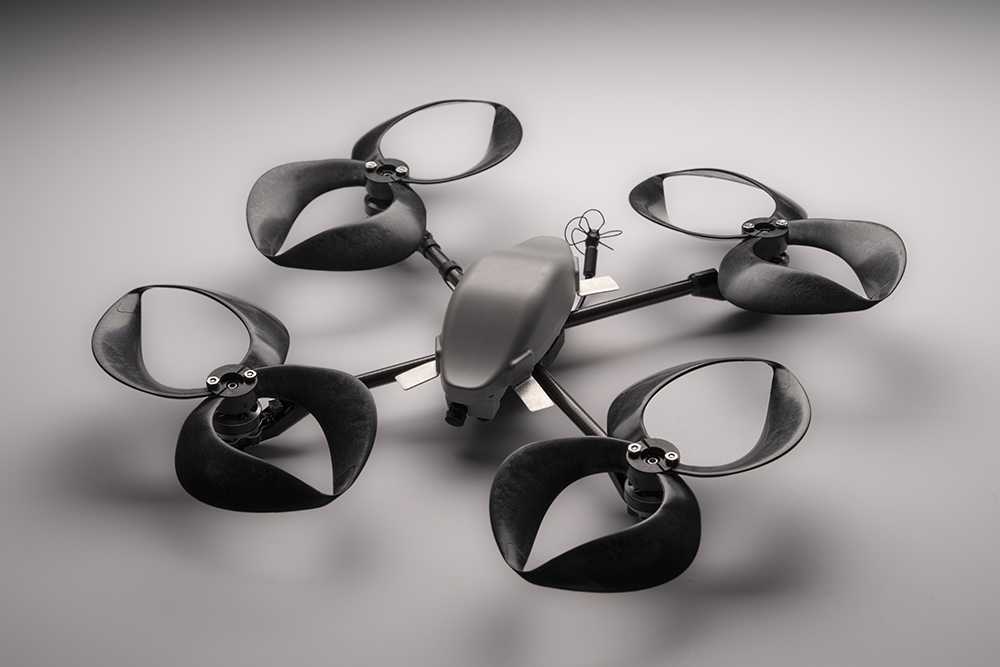Six Lincoln Laboratory inventions win 2022 R&D 100 Awards
Technologies recognized with "Oscars of Innovation" transform hurricane tracking, electronics cooling, collision avoidance, cybersecurity, and more.

Six technologies developed at MIT Lincoln Laboratory are among this year's R&D 100 Award winners. The awards recognize the 100 most significant innovations that have transitioned to use or been made available for sale or license in the past year.
R&D World magazine manages the awards program, which has run annually since 1963. The worldwide competition, dubbed the "Oscars of Innovation," is judged by a panel of science and technology experts and industry professionals.
Lincoln Laboratory's awardees represent a range of research and development areas. One technology is a revolutionary hurricane-tracking satellite. Another is a quiet propeller design for small commercial drones, and one is a system that can prevent drone collisions in the national airspace. Two awardees are tackling problems of technology overcrowding: one by allowing different devices to simultaneously use the same radio frequency band, and another by keeping densely packed electronics cool. And finally, a cybersecurity tool is recognized for its ability to prevent a pervasive type of cyberattack.
"Our R&D 100 Awards represent a major accomplishment for transitioning technology outside of the laboratory. We are very proud of everyone involved in this groundbreaking work," says Eric Evans, the director of Lincoln Laboratory.
Airborne Collision Avoidance System sXu
Today, small drones, or uncrewed aircraft systems (sUAS), are generally not authorized to fly in the U.S. National Airspace System. U.S. law requires all air vehicles to be able to see and remain clear of conflicting air traffic — and sUAS have neither a pilot on board nor a technical solution to meet this requirement. Lincoln Laboratory developed the Airborne Collision Avoidance System sXu (ACAS sXu) to enable unrestricted sUAS operation in the national airspace. The system allows sUAS to detect and track other nearby aircraft, and then automatically maneuvers the sUAS away from those aircraft to avoid a potential mid-air collision (or alerts its ground operator to make such a maneuver). ACAS sXu can be installed on the sUAS or employed as a remote service, and is adaptable across the wide range of sUAS vehicle types. The ACAS sXu design standard was finalized in 2022, and the Federal Aviation Administration (FAA) is developing policy and procedures to approve use of this system.
Lincoln Laboratory shares this award with its collaborators on the technology: the U.S. Federal Aviation Administration, MITRE, and Johns Hopkins University Applied Physics Laboratory.
Constrained Communications and Radar Dual-Use
Radar and wireless communications systems typically operate in separate radio frequency (RF) bands to avoid cross-interference. However, today’s abundance of wireless devices is crowding the RF spectrum — a problem that is leading researchers to explore ways for technologies to share the same RF bands to free up space.
The Constrained Communications and Radar Dual-Use (CONCORD) technology enables such band sharing. CONCORD is a method of designing waveforms that can perform both radar and communications tasks simultaneously, with the same transmitter and receiver. This method allows a system designer to unify the hardware used for these tasks, simplifying a system's design and lowering costs. CONCORD has applications for any military or commercial systems that need to sense objects with radar and send out data, such as airborne radar imaging systems or self-driving cars.
Embedded microjet cooling for high-power electronics
Electronics are becoming smaller and more powerful. These increased power densities are approaching the limit of what conventional thermal architectures can manage. Electronics designers are thus looking for new cooling solutions to meet performance requirements and reduce energy costs.
Lincoln Laboratory's embedded microjet cooling technology uses arrays of micron-scale fluid jets to cool high-power devices. These arrays are small enough to be embedded directly into the device at the chip level. This integration allows fluid to flow directly up to the electronics' semiconductor substrate, delivering an order-of-magnitude improvement in heat transfer over heat sinks or cold plates that pass cooling fluid parallel to the substrate. The microjets can be fabricated from low-cost materials, such as silicon or plastics, and can be mass produced with existing foundry tools. An MIT spinoff company, JETCOOL Technologies Inc., is commercializing this technology.
Toroidal propeller
Anyone who has encountered a small hobby drone flying nearby has likely noticed the high-pitched buzz of its propellers. Experiments by NASA have shown that humans find this sound to be more annoying than any other vehicle noise. If drones are to be accepted for wider use, such as for package delivery, they’ll likely need to be quieter.
Lincoln Laboratory's toroidal propeller is significantly quieter than common multirotor propellers, while producing comparable thrust. The toroidal propeller consists of looped blades, in which the tip of a leading propeller blade is curved back into its trailing propeller blade. This closed structure minimizes the strength of trailing tip vortices and increases the overall stiffness of the propeller, both of which reduce its noise; it is also less likely than conventional propellers to catch on or cut objects in its path. The propeller can be 3D printed and customized to a range of vehicles, making it suitable as a drop-in replacement on current drones.
Timely Address Space Randomization
Timely Address Space Randomization (TASR) addresses the problem of memory corruption, one of today's most prevalent cyber vulnerabilities. Hackers who launch memory corruption attacks can gain control of or steal data from millions of computers at once because the memory structures in these systems all look alike. TASR prevents such attacks by automatically shuffling, or re-randomizing, the location of code in memory.
TASR improves upon an existing solution deployed in most modern operating systems, called address space layout randomization (ASLR), which uses a similar premise of randomizing memory layout. The problem with ASLR is that it randomizes memory just once, and attackers have worked around that solution by using "information-leakage attacks" to force an application to reveal how its memory has been randomized. TASR is the first technology to mitigate such attacks by randomizing layout every time it observes an output from an application. TASR is compatible with existing cyber infrastructure and incurs a very low overhead. InfoSiftr, a cloud development company, has licensed TASR.
TROPICS Pathfinder satellite
According to the National Oceanic and Atmospheric Administration, the frequency and intensity of hurricanes are expected to rise throughout this century. To provide scientists with more data over the Earth's tropical belt where these storms form, Lincoln Laboratory conceived of the TROPICS mission. TROPICS is a constellation of small satellites, called CubeSats, that will work together to provide global, rapid-revisit views of tropical storms. The TROPICS Pathfinder satellite was launched in 2021 as the first in this constellation.
Aboard the satellite is a microwave sounder, a sensor that produces high-resolution, 3D images of the temperature and water vapor content of the Earth's atmosphere along with estimates of precipitation intensity. The microwave sounder measurements are ingested into numerical weather models to produce a forecast (and provide the greatest contribution to reducing forecast error of all ingested data types). The greatest technical challenge in developing the TROPICS Pathfinder was the miniaturization of the sensor. Over the past 10 years, Lincoln Laboratory incrementally shrank the sensor from the size of a washing machine to that of a coffee cup, enabling its use on CubeSats. This R&D 100 Award is shared with NASA and Blue Canyon Technologies.
Technology transfer
Since 2010, Lincoln Laboratory has received 81 R&D 100 Awards. The awards recognize the laboratory's transfer of unclassified technologies to industry and government. Each year, many technology transitions also occur for classified projects. This transfer of technology is central to the laboratory's role as a federally funded research and development center.
The 2022 award recipients will be honored at a banquet in Coronado, California, on Nov. 17.





































